Transform your outdoor space into a delightful herb garden with 27 unique herbs that can elevate your cooking and gardening experience. Whether you’re a seasoned gardener or just starting out, growing your own herbs not only adds flavor to your meals but also brings a touch of greenery and life to your backyard. Let’s dig in and explore the delightful world of gardening!
Soil Preparation Techniques for Healthy Herbs

Getting your soil ready is key to growing healthy herbs. In the image, you can see someone loading a wheelbarrow with rich, dark compost. This is a vital step in soil preparation. Compost adds nutrients and improves soil structure, which allows herbs to thrive.
First, clear the area where you plan to plant your herbs. Remove any weeds or old plants. This gives your herbs the best start possible. Next, mix in organic matter like compost or well-rotted manure. This enhances drainage and keeps the soil moist.
As you prep the soil, consider its texture and pH. Herbs generally prefer well-drained soil with a pH between 6 and 7. If your soil is too compact, loosen it up with a shovel or tiller. This will help root systems grow more easily.
Don’t forget to test your soil. You can find simple kits at garden centers. Knowing the nutrient levels helps you decide what to add. Once your soil is ready, you can start planting your favorite herbs!
Watering Guidelines for Optimal Herb Growth

In an outdoor herb garden, proper watering is essential for your plants to thrive. The image perfectly illustrates this with a watering can pouring water over young, vibrant herbs. You can see freshly watered soil, which is crucial for promoting healthy growth.
One key aspect to remember is that herbs prefer well-drained soil. Overwatering can lead to root rot, so ensure you’re not flooding your plants. Water them deeply, but allow the top inch of soil to dry out between waterings.
It’s also important to consider the weather. On hot, sunny days, your herbs may need more water compared to cooler, cloudy days. Check your plants regularly; they’ll let you know when they’re thirsty by drooping slightly.
Use a watering can like the one in the image, which allows for a gentle pour, preventing soil erosion. Additionally, try to water in the morning. This helps the herbs absorb moisture before the sun heats the soil and leaves.
Choosing the Right Location for Your Herb Garden

When selecting a spot for your herb garden, consider the layout and the elements that surround it. The image showcases a vibrant outdoor garden area filled with various plants. Alongside the neatly arranged herbs, you can see gardening tools like a shovel and a rake, which indicate an active gardening space.
One key factor in choosing the right location is sunlight. Herbs thrive in areas that receive plenty of light. Look for a spot that gets at least six hours of direct sunlight daily. The greenery in the background shows the potential for a sunny environment, which is ideal for growing herbs.
Another consideration is accessibility. You want to ensure that reaching your garden is easy. The clear path in the image allows for easy movement, making it convenient to tend to your plants. Make sure you can easily get to your herbs for watering, harvesting, or cooking.
Finally, think about drainage. Herbs don’t like soggy soil. The garden shown has well-defined soil areas, which can help prevent water from pooling around the plants. Choosing a location with good drainage will keep your herbs healthy and flourishing.
Companion Planting Strategies for Herbs

In this vibrant garden scene, you can see an array of herbs growing harmoniously together. The mixture includes various textures and shades of green, showcasing the beauty of nature and the benefits of companion planting.
Companion planting is about placing plants together that can benefit one another. For example, rosemary and basil thrive when planted near each other. Rosemary can help repel pests that might harm basil.
The image highlights the lush, leafy greenery typical in herb gardens. You might notice some herbs are taller, like the rosemary, while others, such as mint or oregano, are more compact. This diversity not only enhances the visual appeal but also supports a healthy ecosystem.
Another great pairing is cilantro and chives, which can coexist perfectly. They not only share similar growing conditions but also attract beneficial insects that help control pests. When planning your garden, think about these relationships to ensure your herbs flourish.
Using different heights and leaf shapes can also help maximize space in your garden. Taller plants can provide shade for shorter ones, creating a microclimate that keeps the soil moist. So, when you’re arranging your herbs, keep an eye on how they interact with one another!
Growing Herbs from Seeds vs. Transplants

In this vibrant herb garden, you can see young plants thriving in their cozy little pots. Each plant is labeled, giving a sneak peek into the variety of herbs being grown. The lush green leaves are a sign of healthy growth, and it’s exciting to think about how these herbs will enhance our meals.
When deciding whether to grow herbs from seeds or transplants, there are some key differences to consider. Starting from seeds can be a rewarding experience, allowing you to see the entire growth process. It does require a bit more patience, as seeds take time to sprout and grow. However, it can be more cost-effective and you can choose from a wider variety of seeds.
On the other hand, using transplants gives you a head start. These young plants are already established and can quickly adapt to their new environment. This method is ideal for those who want to enjoy fresh herbs sooner. Plus, you get to skip the sometimes tricky seed-sprouting phase.
Ultimately, the choice depends on your gardening style and how much time you want to invest. Whether you go for seeds or transplants, nurturing these plants brings a sense of fulfillment, and the rewards are delicious!
Herbs That Thrive in Containers

Container gardening is a delightful way to grow herbs, especially if you have limited space. This charming image showcases a vibrant collection of potted plants, creating a warm and inviting atmosphere perfect for any garden lover.
Herbs like basil, parsley, and cilantro flourish in containers. They need good drainage and plenty of sunlight, making pots an ideal choice. The colorful flowers in the image add an extra touch of personality, complementing the greenery of the herbs beautifully.
When choosing containers, opt for those that allow air circulation through the roots. Plastic or clay pots work well, but remember to ensure they have drainage holes. This prevents water from sitting at the bottom, which can lead to root rot.
Regularly watering your herbs is essential, especially in warmer months. Check the soil moisture daily, and water when it feels dry to the touch. Additionally, feeding your herbs with a balanced fertilizer every few weeks can encourage growth and flavor.
Don’t forget to harvest your herbs regularly. This promotes new growth and ensures a continuous supply for your kitchen. Whether you’re adding fresh basil to pasta or garnishing a dish with cilantro, homegrown herbs are a fantastic addition to any meal!
Essential Tools for Herb Gardening Success

Herb gardening can be a delightful way to enjoy fresh flavors right from your backyard. To get started, having the right tools makes all the difference. The image above showcases a variety of essential gardening tools laid out neatly on a wooden table, ready for action.
First up are the gloves. Wearing a good pair protects your hands while working in the dirt. The blue gloves seen here look sturdy, perfect for digging and planting. Pair them with tools like a trowel and a hand cultivator, which are both essential for planting seeds and loosening the soil.
You’ll also notice a watering can, which is crucial for keeping your herbs hydrated. A gentle pour helps avoid disturbing young plants. The pots in the background, filled with soil, hint at the new herbs waiting to grow. Remember, proper drainage is vital, so ensure your pots have holes at the bottom.
Other handy tools include a weeder for removing pesky weeds and a spade for deeper digging. Each tool has its purpose, making it easier to manage your herb garden without too much hassle.
With these essential tools, you’ll be well on your way to creating a thriving herb garden. So gather your gear, roll up your sleeves, and get ready to dig in!
Sunlight Requirements for Different Herbs

Growing your own herb garden is a delightful way to enhance your cooking and enjoy the outdoors. Different herbs have varying sunlight needs that can impact their growth and flavor. Understanding these requirements is key to a thriving garden.
The vibrant herbs in the image showcase a lush green setting, indicating they are receiving plenty of sunlight. Most herbs prefer full sun, which means at least six hours of direct sunlight daily. This is especially true for sun-loving varieties like basil, rosemary, and thyme.
However, some herbs, such as parsley and mint, can tolerate partial shade. If you’re gardening in a spot that doesn’t get all-day sun, these are great options. Placing these herbs where they can receive morning sun is often beneficial, as it helps them absorb light without the intense heat of midday.
To make the most of your herb garden, consider the sunlight your space receives throughout the day. This will guide your choices and placement, ensuring each herb thrives in the right conditions. Whether you’re using them for cooking or garnishing, healthy herbs will elevate your dishes.
Herbs for Culinary Uses in Everyday Cooking
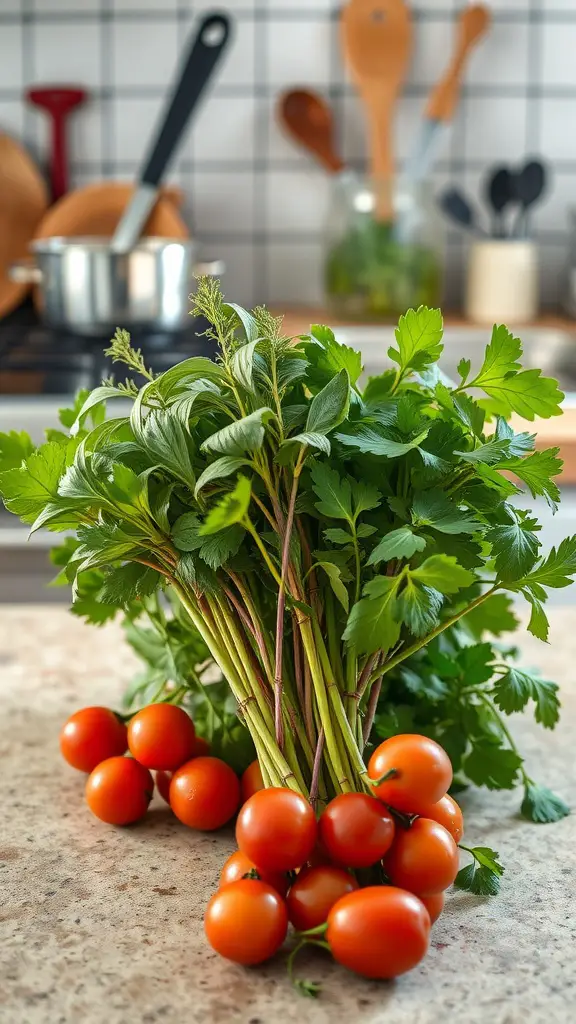
In the heart of any kitchen, fresh ingredients can make a big difference. The image captures a vibrant bunch of herbs alongside some bright, juicy tomatoes, showcasing the beauty of home cooking.
Using fresh herbs like parsley and cilantro can elevate your dishes. These herbs are not just for decoration; they bring out flavors and add a fresh touch to your meals. Whether you’re tossing them in salads or using them as garnishes, they can transform ordinary food into something special.
Imagine making a simple tomato salad. Start with ripe tomatoes, slice them, and toss them with chopped parsley, a drizzle of olive oil, salt, and a squeeze of lemon juice. The freshness of the herbs complements the sweet tomatoes perfectly.
Another delicious option is a herb-infused pasta. Cook your favorite pasta, and just before serving, stir in fresh herbs like basil or parsley. Add a sprinkle of parmesan for extra flavor.
Keeping a small herb garden outdoors can be a fun project. You can easily grow parsley, basil, or even mint. Having these herbs on hand will encourage you to include them in your everyday cooking.
Fertilizing Techniques for Lush Herbs

In an outdoor herb garden, the right fertilizing techniques can make all the difference. The image captures a hand using a tool to sprinkle nutrient-rich soil into a container, showing how easy it is to add essential nutrients to your herbs.
When growing herbs, starting with quality soil is key. The yellow container in the picture suggests a handy way to keep your fertilizing materials organized. You can fill it with compost or organic fertilizer to ensure your plants get what they need.
Herbs like basil, parsley, and cilantro thrive with regular feeding. They generally prefer a balanced fertilizer, so something with equal parts nitrogen, phosphorus, and potassium works well. Just remember, less is often more. Over-fertilizing can lead to lush foliage but lack of flavor.
Another fun technique is to use compost tea. Simply steep some compost in water for a few days and use it to water your herbs. This organic solution provides a gentle boost to your plants, ensuring they stay healthy and flavorful.
In summary, nourishing your herbs through thoughtful fertilization practices will help you enjoy a bountiful garden. Keep experimenting with different methods and watch your herbs flourish!
Organic Pest Control for Herb Gardens

In an herb garden, keeping your plants healthy is key. The image features a spray bottle in a lush green garden filled with herbs. It’s a simple tool for organic pest control. Using natural methods keeps the garden safe for both plants and people.
Herb gardens can attract various pests, but there are many ways to manage them without harmful chemicals. For example, mixing water with a few drops of dish soap can create a gentle insecticide. Just spray it on the affected areas to help keep pests at bay.
Another popular method is using essential oils. Oils like peppermint and neem are great for deterring bugs. You can mix a few drops with water in your spray bottle for a natural repellent.
Additionally, planting companion herbs, like basil near tomatoes, can naturally repel certain pests while promoting healthy growth. It’s all about finding balance in your garden!
Seasonal Herb Planting Calendar

This image beautifully captures a vibrant herb garden alongside a calendar, reminding us of the importance of timing in gardening. The calendar dates are marked, indicating specific days for planting or caring for herbs.
Herbs like basil, cilantro, and parsley are not only delightful additions to dishes but also thrive in seasonal cycles. Observing when to plant these herbs can yield a bountiful garden. It’s always good to know which herbs flourish during spring versus fall.
If you’re planning an herb garden, consider starting seeds indoors a few weeks before the last frost. Once the weather warms up, transplant them outside. Referencing a calendar like the one in the image can help you track these important dates.
Not sure when to harvest? Keep an eye on your calendar and mark down the dates as you go. This will help you get the most flavor out of your herbs and ensure they thrive throughout the growing season.
Pruning and Harvesting Your Herbs
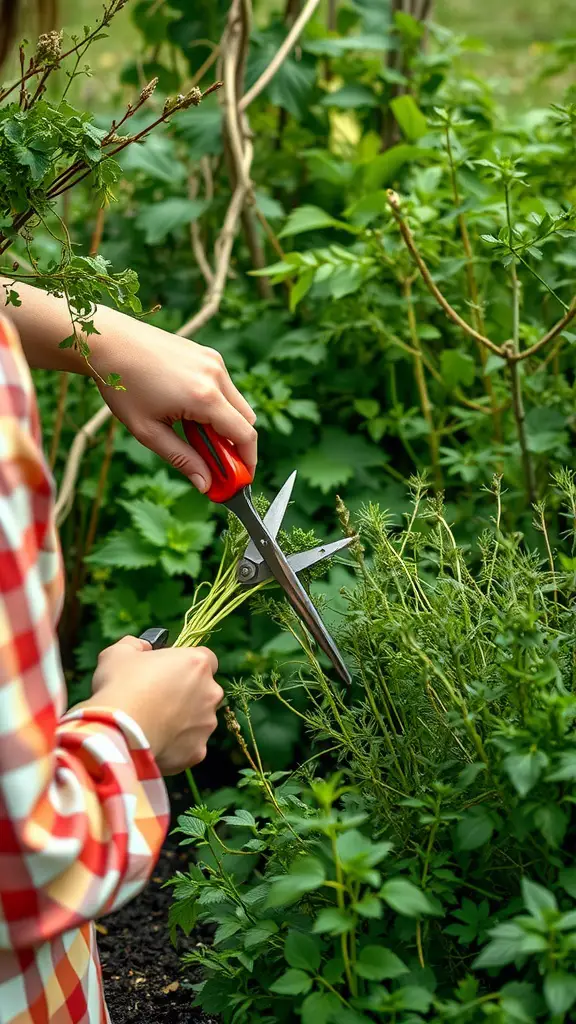
Maintaining a vibrant herb garden is all about timely pruning and harvesting. In the image, a person is seen carefully trimming herbs with a pair of scissors, highlighting the importance of this process. Proper pruning encourages healthy growth and enhances the flavor of your herbs.
When you prune, it’s best to cut stems just above a leaf node. This promotes bushier growth and prevents your plants from becoming leggy. Herbs like basil and thyme respond well to regular trimming. Don’t be shy about harvesting; the more you pick, the more they produce!
Harvesting is also an exciting part of gardening. Snipping fresh herbs for cooking adds a special touch to your dishes. For instance, you can use freshly cut basil in a caprese salad or mix thyme into your roasted chicken. Just remember to wash your herbs before using them in your recipes.
Make sure to prune and harvest in the early morning or late afternoon for the best flavor. At these times, the essential oils in the herbs are at their peak. With regular care, your herb garden will thrive, providing you with fresh flavors all season long.
Creating a Herb Spiral for Space Efficiency

Herb spirals are a fantastic solution for those looking to maximize their gardening space. In the image above, you can see a beautifully arranged herb spiral nestled in a compact area. This design allows for an array of herbs to flourish while making the most out of limited square footage.
The spiral shape creates different microclimates, which is ideal for various herbs that may have specific sunlight and moisture needs. For instance, the top of the spiral often gets more sun and drains well, making it perfect for Mediterranean herbs like rosemary and thyme. Meanwhile, the lower parts retain moisture, which suits herbs like mint and parsley.
To create your own herb spiral, start with a sturdy base, such as a wooden barrel or stones. Then, build upward in a spiral pattern using soil. You can begin planting your herbs in the wider outer rings and gradually fill in the inner spiral with more delicate herbs. This design not only looks great but also offers an easy way to access your herbs while keeping them organized.
In the image, you can also spot some companion plants, which can help attract beneficial insects and deter pests. Adding flowers or other plants to your herb spiral can enhance its beauty and function. It’s a win-win for your garden!
Preserving Herbs for Year-Round Use
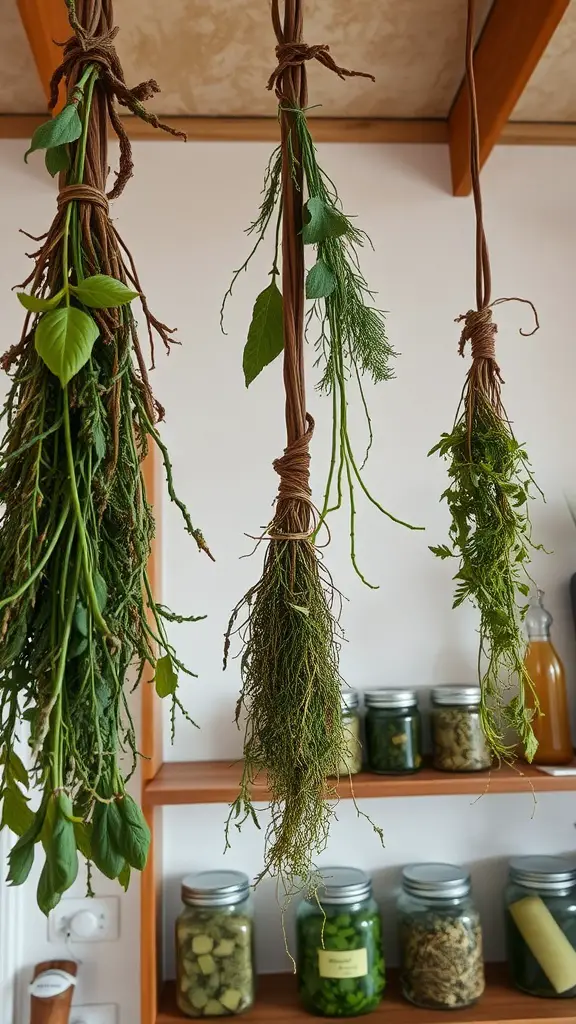
In the image, we see a lovely display of freshly harvested herbs hanging from a wooden rack. This simple yet effective method of preservation allows you to enjoy the flavors of your garden all year round.
Hanging herbs is a time-honored technique that not only saves space but also enhances the beauty of your kitchen. The herbs appear vibrant and green, showcasing their freshness before they dry. In the background, jars filled with preserved herbs and other ingredients hint at the joys of home cooking.
To preserve your herbs, start by selecting healthy stems. Make sure they’re clean and dry before tying them together. A simple string or twine works well to secure them. Hang them upside down in a warm, dry area away from direct sunlight. In a few weeks, you’ll have dried herbs ready for use in your favorite dishes.
Once dried, store your herbs in airtight jars. Label them for easy identification. This way, you’ll have your favorite flavors ready whenever you need them! Whether it’s adding freshness to a soup or enhancing a salad, preserved herbs will bring a delightful touch to your meals.
Herb Garden Design Ideas for Aesthetic Appeal

Creating a beautiful herb garden can transform your outdoor space into a relaxing retreat. The image above captures a lovely garden design, with winding pathways and a lush variety of plants. This type of layout invites you to explore each section, making it not just functional but also visually appealing.
Notice how the garden uses natural stone pavers to create a charming path. These stones provide a clear route through the greenery, guiding you past vibrant flowers and aromatic herbs. Incorporating curves in the design adds a soft, organic feel, making the garden look less rigid and more inviting.
Incorporating raised beds or trellises with flowering plants enhances the garden’s aesthetic while offering practical benefits. The flowers can attract beneficial insects, and the structured elements add height and variety to the garden landscape. This combination of herbs and flowers creates a sensory experience, where sight and smell work harmoniously together.
Additionally, consider using pots and planters for herbs that may need extra attention or specific soil conditions. This allows for easy access and can add layers to your garden’s design. With thoughtful placement, even small spaces can become lush herb gardens.
Attracting Pollinators to Your Herb Garden
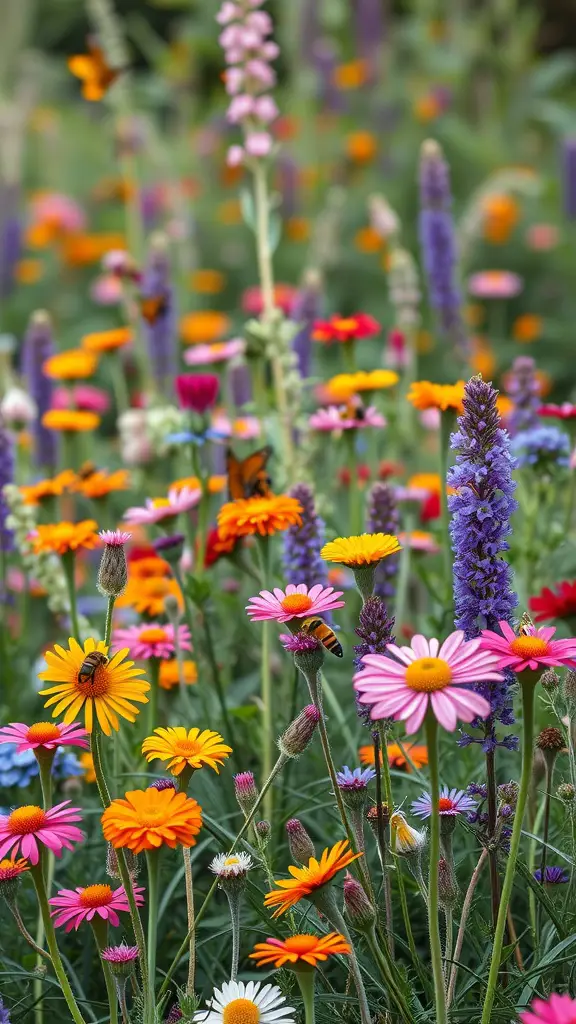
Creating a vibrant herb garden is not just about growing your favorite herbs; it’s also about inviting nature into your space. The image showcases a colorful palette of flowers, each playing a vital role in attracting pollinators like bees and butterflies. These essential creatures help your herbs thrive.
Pollinators are drawn to bright colors and sweet scents, which the flowers in the image perfectly display. By planting a variety of flowers alongside your herbs, you’ll encourage more bees and butterflies to visit. This increases the chances of your herbs producing more flowers and seeds, enhancing your garden’s yield.
Consider choosing flowers like daisies, cornflowers, and calendulas, as they’re known to attract these friendly pollinators. It’s also beneficial to plant herbs such as basil, thyme, and mint, which can provide additional nectar sources. The more diverse your garden, the more pollinators you’ll invite.
Remember to avoid pesticides, as these can harm pollinators. Instead, focus on creating a welcoming environment. Providing water sources and shelter can also encourage pollinators to stick around. With a little effort, your herb garden can become a buzzing haven for these vital creatures.
Medicinal Properties of Common Herbs

In the image above, we see a vibrant array of herbs laid out on a wooden surface. Each herb is carefully labeled, showcasing their unique names. This setup is not just visually appealing; it reflects the rich history and importance of herbs in traditional medicine.
Herbs like mint and thyme, often found in backyards, offer more than just flavor. For instance, mint can aid digestion and provide relief from headaches. Thyme is known for its antimicrobial properties, making it a popular choice for supporting the immune system.
The arrangement also includes herbs like lavender and rosemary. Lavender is famous for its calming effects, making it a go-to for anxiety and sleep issues. Rosemary is not just a culinary delight; it’s also linked to improved memory and concentration.
Using these herbs in daily life is easy. You can simply brew them as teas, sprinkle them in your meals, or even create essential oil blends at home. Each herb brings a unique set of benefits, allowing you to tailor your choices based on your health needs.
Herbs That Deter Common Garden Pests
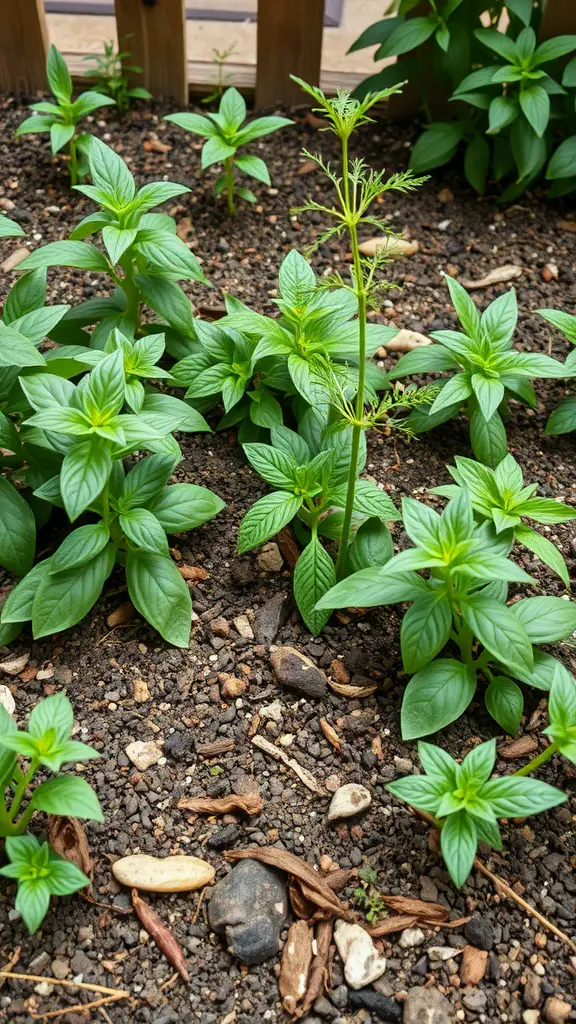
In the image, vibrant green herbs thrive in a well-tended garden bed. These plants not only add beauty but also serve a purpose: deterring pests. Placing herbs like basil and cilantro around your garden can help keep unwanted insects at bay.
Basil is particularly effective against flies and mosquitoes. Its strong scent confuses these pests and prevents them from settling in your garden. Adding a few basil plants around your other vegetables can create a natural barrier.
Cilantro, on the other hand, attracts beneficial insects like ladybugs, which feed on common pests such as aphids. By planting cilantro, you invite helpers into your garden while keeping pests under control.
Other herbs, such as mint and rosemary, also have pest-repelling qualities. Mint is known for deterring ants and beetles, while rosemary can ward off flies and mosquitoes. Incorporating these herbs into your garden not only protects your plants but also provides fresh ingredients for your kitchen.
Herb Garden Maintenance Tips for Longevity

Taking care of your herb garden is key to enjoying a bountiful harvest for years to come. In the image, a gardener, wearing a straw hat and gloves, is tending to the flourishing plants. The vibrant greenery around him showcases the potential of a well-maintained herb garden.
First and foremost, regular watering is essential. Herbs generally thrive in well-drained soil, so make sure not to overwater. A good rule of thumb is to check the soil moisture first. If the top inch feels dry, it’s time to give your herbs a drink.
Next, make sure to prune your herbs. This encourages bushier growth and helps to prevent diseases. The gardener in the image seems to be inspecting his plants closely, which is a great habit. Look for any dead leaves or flowers and remove them promptly.
Fertilizing is another crucial aspect. Using organic fertilizers can provide the necessary nutrients without harming the environment. Just remember to apply it sparingly; too much can stress your plants.
Finally, keep an eye out for pests. Regular checks will help you catch any issues early on. The gardener looks focused on his plants, which is a perfect reminder to stay vigilant.
Using Herbs in Natural Home Remedies

Herbs are not just for flavoring food; they also have great benefits for our health. In this image, you can see a fresh herb plant, likely ready to be used in various natural remedies. Keeping a herb garden can provide you with easy access to these valuable plants.
On the table, you see different containers filled with liquids and powders. These may include herbal extracts, oils, and dried herbs, all of which are essential in crafting home remedies. For instance, infused oils can be made by steeping herbs in a carrier oil, perfect for soothing skin irritations.
Many herbs have specific properties. For example, rosemary and lavender can help relieve stress, while ginger and honey can ease digestive issues. Having these herbs handy allows you to mix up simple remedies right at home.
Creating a herbal remedy could be as easy as combining honey with ginger to make a soothing drink or using lavender oil for relaxation. The possibilities are endless. So, consider starting your own herb garden and explore the benefits of natural home remedies!
Herbs That Do Well in Shade

When you think of an herb garden, you might picture sunny spots filled with vibrant greens. However, many herbs actually thrive in shaded areas. The image shows a lush herb garden growing in a shaded nook. The variety of leafy greens suggests it’s full of potential for flavor and culinary delights.
Some herbs that flourish in the shade include parsley, chives, and mint. These herbs don’t need full sun to thrive, making them perfect companions for those areas in your garden that don’t receive a lot of light. For instance, parsley adds a fresh taste to salads and dishes, while mint can elevate beverages and desserts.
To create a shady herb garden, start by preparing your soil well. Ensure it’s rich and well-drained to keep your herbs healthy. You can plant these herbs closely together, as they often enjoy the company of each other. Water them regularly, but be careful not to overwater, especially since shaded areas can retain moisture more than sunny spots.
Don’t forget to harvest your herbs regularly. This encourages growth and ensures you have fresh flavors to add to your meals. With a little care, your shaded herb garden can provide a delightful bounty all season long!
Exploring Heirloom and Rare Herbs for Your Garden

When it comes to adding flavor and excitement to your outdoor herb garden, heirloom and rare herbs can truly elevate your experience. In the image, a vibrant selection of herbs and plants awaits discovery, each labeled with care. These herbs not only add unique tastes to your dishes but also bring a rich history to your garden.
Consider growing herbs like Lemon Balm or Bee Balm, which are known for their delightful scents and culinary uses. Imagine stepping outside to grab fresh mint for a refreshing drink on a hot day or using delicate chervil in a gourmet meal. These herbs are not just plants; they are an invitation to explore flavors and traditions.
Heirloom herbs, passed down through generations, often have unique qualities that make them stand out. They can be a conversation starter among friends and family, bringing stories of their origins into your cooking. Think of how fun it would be to share the history of your garden’s lavender or the special care needed for your rare basil varieties.
As you plan your herb garden, consider mixing in some rare varieties. These can be a wonderful surprise for your taste buds and can even inspire you to try new recipes. A simple herb butter made with your homegrown herbs can elevate any dish. Just mix softened butter with finely chopped herbs, a pinch of salt, and a squeeze of lemon juice.
So, as you explore heirloom and rare herbs, think of the endless possibilities they offer. Whether you’re using them in recipes or simply enjoying their beauty, they are sure to bring joy to your outdoor space.
Connecting with Nature Through Herb Gardening

Herb gardening is a fantastic way to connect with nature while enjoying the benefits of fresh ingredients right at your fingertips. This image beautifully captures a moment in an outdoor herb garden where someone is taking a moment to soak in the surroundings. The vibrant greenery all around creates a calming atmosphere, inviting anyone to get involved.
In the garden, you can find a variety of herbs, each with its unique scent and flavor. Imagine picking fresh basil for a homemade pesto or snipping some rosemary for a roasted chicken. These moments of connection with the earth can be very rewarding.
Taking care of herbs also teaches us patience and mindfulness. Each plant needs attention, whether it’s watering, pruning, or harvesting. By engaging with these tasks, you become more in tune with the cycles of nature. Plus, seeing your plants thrive is truly a satisfying experience!
So, if you’re considering starting your herb garden, think about your favorite dishes. Herbs like cilantro, mint, and thyme can elevate your cooking in simple yet delightful ways. Just imagine the joy of preparing a meal where you can say, ‘I grew that!’ It’s not just about the herbs; it’s about creating a deeper bond with the environment around you.
Creating a Vibrant Herb Garden Layout

When setting up your herb garden, the layout is key to both beauty and functionality. In the image, we see a charming arrangement of raised garden beds filled with a variety of herbs. Each box is neatly organized, making it easy to identify each plant. A stone pathway runs between the beds, allowing for convenient access and a pleasant stroll through the garden.
Using raised beds, as shown, can help in managing soil quality and drainage. You can plant herbs like basil, thyme, and parsley side by side for easy harvesting. Consider including a mix of colors and textures to make the garden visually appealing. The green hues of the leaves paired with the vibrant colors of blooming flowers create a lively atmosphere.
Don’t forget about spacing! Each plant needs room to grow, so be mindful of placing them too close together. This layout also enhances airflow, reducing the risk of disease. Plus, the path allows for easy maintenance, letting you get to the plants without stepping on the soil and compacting it.
Incorporating a variety of herbs not only makes your cooking more flavorful but can also attract beneficial insects to your garden. Try adding some mint or rosemary to your beds for a lovely fragrance. With a little planning, you can transform your outdoor space into a lovely herb sanctuary.
Seasonal Herb Maintenance Tips

In a thriving herb garden, seasonal maintenance is key to keeping your plants healthy and productive. The image captures an enthusiastic gardener tending to their herbs, highlighting the hands-on approach needed for successful herb cultivation.
Start by checking your herbs regularly for any signs of pests or disease. Early detection allows for quick action, ensuring your plants stay vibrant. Using organic pest control methods can help maintain the health of your garden.
Watering is essential but should be done with care. Herbs often prefer slightly dry conditions between waterings. Stick your finger in the soil to check moisture levels; if it feels dry an inch down, it’s time to water.
Pruning is also an important part of herb care. Trim back any overgrowth to encourage new growth and improve air circulation. This not only keeps your plants looking tidy but also boosts their overall health.
Lastly, consider rotating your herbs each season. This practice can prevent nutrient depletion in the soil and reduce the risk of pests. Experimenting with different herbs each year can also keep your garden exciting and fresh!
Herb Garden Workshops and Community Events
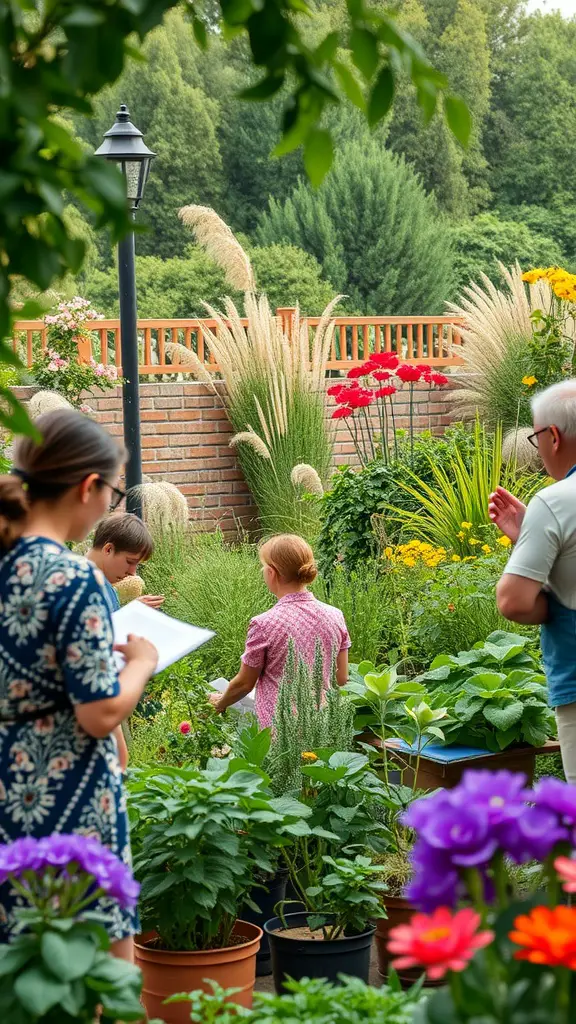
Herb garden workshops are a delightful way to connect with nature and learn about growing your own herbs. In the image, you can see a group of people gathered in a lush garden, surrounded by vibrant plants. They appear to be engaged in hands-on learning, perhaps discussing different herbs or sharing tips on gardening.
Community events like this foster a sense of belonging. They not only provide knowledge but also create opportunities for friendships. Whether you’re a beginner or an experienced gardener, everyone can find something to enjoy and learn.
During these workshops, participants often get to plant their own herbs. Common choices include basil, mint, and rosemary. After planting, you can take these herbs home to use in your cooking. It’s a rewarding experience to grow your own ingredients!
After planting, consider a fun recipe that utilizes the fresh herbs you’ve just grown. For example, a simple herb-infused olive oil makes a fantastic addition to any dish. All you need are some fresh herbs, olive oil, and a jar. Chop the herbs, mix them with the oil, and let it sit for a few days. Enjoy the rich flavors in your meals.
Don’t miss out on local herb garden workshops! They provide a fantastic opportunity to learn, grow, and bond with others who share your interest in gardening.

